Ever since the Intel Atom C2750 announcement in early September 2013 there were a few products announced that received much community attention. One of those is the ASRock Rack C2750D4I we are reviewing today and is anticipated as an excellent storage platform. We already reviewed the Supermicro A1SAi-2750F which utilizes quad gigabit NICs and SODIMMs along with the Intel Atom C2750 processor. That platform is limited to only 6 SATA ports though. With the Intel Atom C2750 performance being solid, ASRock saw an opportunity to build a cold storage platform that combines low power consumption with the ability to handle many disks. These small mITX platforms are really showing some strong innovation as ASRock clearly has a great performer with the C2750D4I.
Test Configuration
Due to the SoC design, the Intel Atom C2750 platform is very compact and requires very little to get up and running. We were able to get a pre-production sample of the ASRock C2750D4I to test. Rumor has it that general availability will occur shortly and it will be found on retailers such as Newegg in the US.Here is our configuration:
- Motherboard/ CPU: ASRock Rack C2750D4I with Intel C2750 Avoton 8C/ 8T SoC
- SSD: Intel S3700 100GB SSD
- Memory: 32GB (4x 8GB) 1600MHz 1.35v Kingston KVR16E11/8I DDR3 DIMMs
- OS: Ubuntu 13.10 server, VMware ESXi 5.5, FreeNAS 9.1.1-RELEASE (see here)
- Power supply: 1U 200w 80+ Gold PWS-203-1H
We also utilized our standard array of PCIe add-on cards from Mellanox and LSI along with Seagate and Western Digital spindle drives to text maximum configurations. Since we were limited to SATA disks we used WD Red and Seagate NAS edition drives mixed across ports.
ASRock Rack C2750D4I Overview
For those wondering about Intel Atom C2750 power consumption and performance you can check our recent pieces here: power testing and performance testing. For the ASRock C2750D4I there are a few major features that need to be covered. The motherboard is a mITX form factor, making it compact enough to fit virtually any chassis. Power is delivered by a 24-pin ATX power supply. In the vast majority of cases, the ASRock C2750D4I is expected to be a stand alone motherboard without need for expansion cards. The small size allows for it to be packed alongside many SATA disks for dense 1U Hadoop or cold storage nodes.
The large low profile heatsink covers the Atom C2750 Avoton processor which contains 8 processing cores. Expect performance to be about half of what one would see from an Intel Xeon E3-1220 V3 processor, yet consuming significantly less than half of the platform power. A quick note here is that ASRock does expect the CPU heatsink to be supplied with airflow from chassis fans, but in our testing the airflow requirements are very minimal with slow and silent 120mm fans easily able to keep the processor cool under load. This makes sense since the C2750 is a 20w TDP part. Along with the Atom C2750 there are two Marvell SATA controllers, two gigabit Ethernet controllers and a PLX chip that all require at least a small amount of airflow. For those looking to build a quiet NAS enclosure with one of these, it is certainly possible but one does need to give the platform at least a minimal amount of airflow.
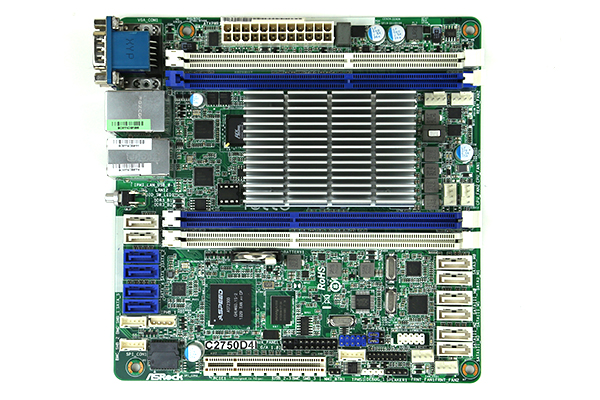
Another key design choice was to use full-length DDR3 DIMM slots. The Supermicro competitor uses SODIMMs commonly found in laptops. There are many more choices for ECC DDR3 UDIMMs in the full size form factor over the SODIMM form factor. The downside is that they are much larger so they take up a lot of PCB area.
While the system is meant to run primarily with onboard components, there is a PCIe 2.0 x8 slot on the motherboard. For those wondering, it is open-ended so a user can add an x16 card in there. One great example would be a LSI 9202-16i that adds 16 SAS/ SATA ports to the platform, potentially allowing for a very large storage platform. ASRock’s engineers also did a good job of keeping components behind the PCIe slot clear so they would not obstruct a larger card.
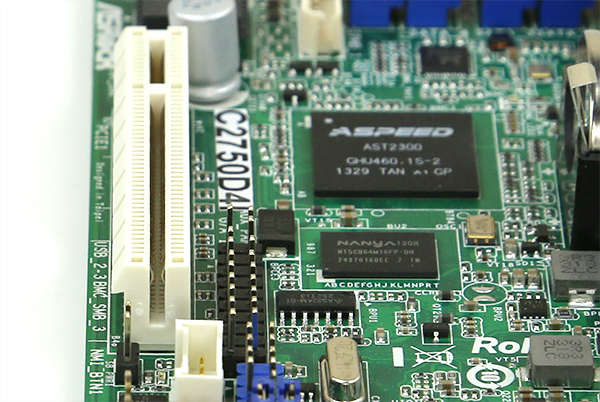
Just above the PCIe slot there are six SATA ports, two SATA III 6.0gbps ports and four SATA II 3.0gbps ports. These are linked to the Intel controller and are fairly standard on Intel Atom C2750 platforms.
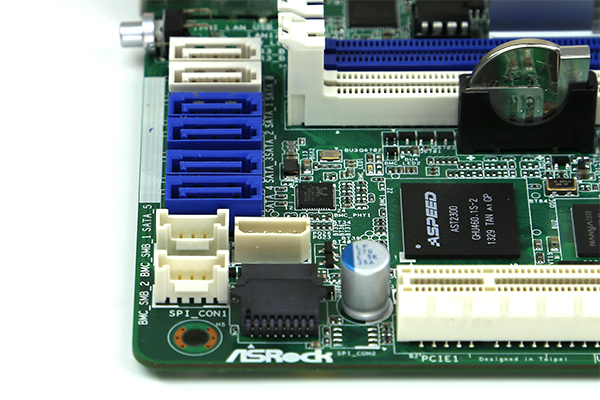
The lower right side of the motherboard shows off a key feature of the ASRock C2750D4I: six additional SATA ports courtesy of dual Marvell controllers (the smaller chips to the left of the SATA ports.) These six SATA III 6.0gbps ports are powered by Marvell SE9230 and SE9172 controllers supporting 4 and 2 of the ports respectively. This is a major point of differentiation because it allows for an additional six disks to be loaded without the need for an add-in controller. Both controllers use about 1w of power each so they are a very energy efficient way to add additional storage ports to a system.
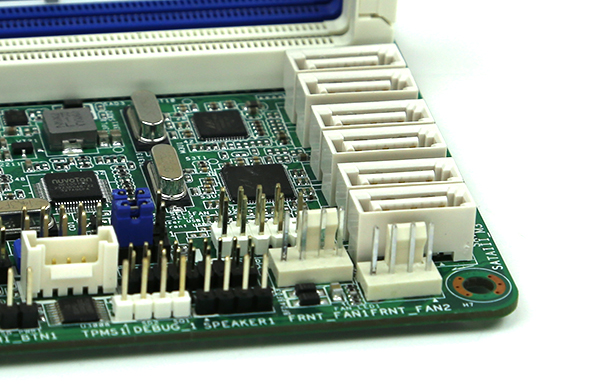
Another major design variation for the ASRock C2750 is in the area of networking. ASRock’s engineers went with a dual Intel i210 gigabit Ethernet controllers. When asked why ASRock picked the Intel i210 gigabit Ethernet controllers instead of the onboard Intel i354 controller the reason given was simple. The Intel i210 is going to be used much more widely across various server platforms and is a more proven technology.
Again we see two more 4-pin fan headers next to the SATA ports. There are a total of 6 onboard 4-pin fan headers which should be enough for most systems to have the motherboard control fan speed.
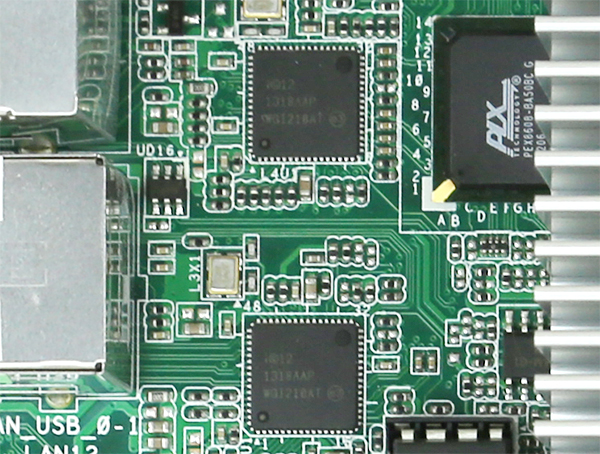
One can also see the PLX PEX8608-BA50BC chip onboard. It is a PCIe Gen 2 switch that allows for additional PCIe lanes to be used for onboard devices and typically uses only 1-2w of power.
The rear panel I/O of the ASRock C2750D4I is fairly straightforward. There is a standard legacy serial port as well as a standard VGA connector. Two USB 2.0 ports provide connectivity for external USB drives, keyboards and mice. There is one LAN port for the Aspeed AST2300 BMC’s onboard IPMI 2.0 functionality. The two additional RJ-45 ports are controlled by the Intel i210 controllers mentioned earlier.
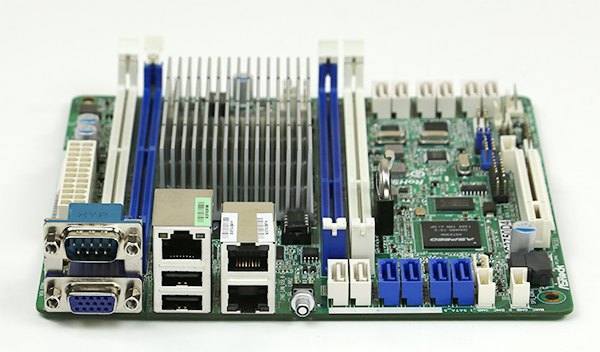
Overall this is a strong storage platform. After using this motherboard for awhile there were two items that might be added in future revisions: internal and external USB headers. Frankly, this motherboard is packed with components so there is simply not much room. With that said, it would be great to have an internal Type-A USB header for a boot drive. Another good option is to have two more USB ports on the rear panel. Most KVM carts in datacenters have USB hubs standard at this point, however some do not. If one needs to attach a USB device that requires more power such as an external DVD ROM and a keyboard and mouse, there are simply not enough USB ports. Then again, adding more USB ports likely means using more PCB space for thier footprint, something that ASRock likely could not do given how much they already fit into the platform. Certainly not a major shortcoming, but would be a “nice to have” in a future revision.
ASRock Rack Remote Management and Monitoring
ASRock uses a common IPMI and KVM-over-IP solution based on the American Megatrends MegaRAC that is paired with the Aspeed AST2300 solution. The solution allows for a lot of deployment flexibility and is similar to the solution found in ASUS, Supermicro, Tyan and some Dell platforms. The solution allows for remote management capabilities such as power control. You can do remote power up, power down, and reset of the server in the event that it becomes unresponsive. Using KVM-over-IP was very simple and allows for a user to remotely mount ISO images, edit BIOS settings and other tools that an administrator would otherwise need to plug a KVM cart up to the system to utilize.
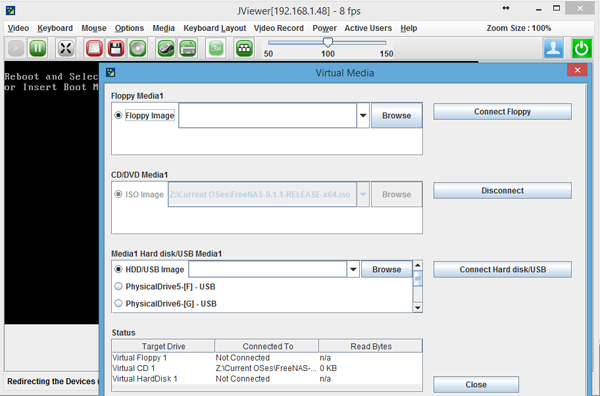
Aside from the management aspect, the solution also has built-in monitoring capabilities. The WebGUI allows an administrator to utilize functions such as fan speeds, chassis intrusion sensors, thermal sensors, and etc. can be monitored remotely. Alerts can be setup to notify the admins of issues.
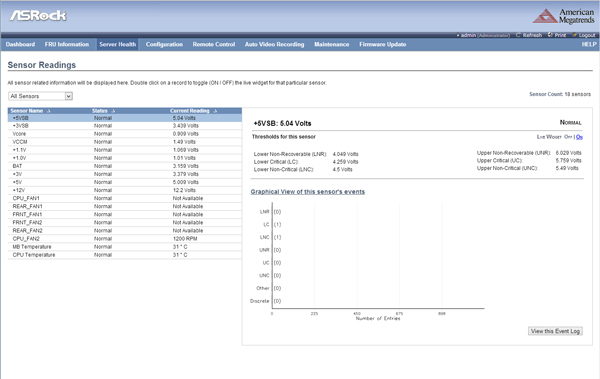
For those wondering, the default username / password on our ASRock C2750D4I was admin / admin. The login information may change on the production samples but often having that information is useful for folks.
Conclusion
The ASRock Rack C2750D4I is going to be a very successful storage platform. ASRock’s team generally used proven technology around a low power Avoton core. That means that without any drives attached, and only the Gigabit NICs plus processor working, the platform will use around 30-35w max. In terms of installation, the mITX size, ability to use add-in cards, and the fact that the Intel Atom C2750 is soldered onboard with an attached heatsink means that the platform fits almost anywhere and is very easy to assemble. As these become generally available, the ASRock C2750D4I is going to be a favorite NAS platform for some time. Overall, a great job by ASRock keeping power consumption low while integrating many SATA ports into a compact storage platform.





Great job guys! I can’t buy these yet? Any idea when they will be available?
I do wish these had a few USB 3.0 ports for backups.
Any idea on price?
Looks like a solid mobo.
Very interesting board!
Great review as usual Patrick! If you install ESXi someday, please let us know if it is possible to pass on the Marvell controllers to a VM.
Keep up the good work!
Robert – these do work with ESXi. The big constraint is that the Intel Atom C2750 does not support VT-d.
I do hope that in the next version this changes.
is there a diagram of the pcie lanes? so does the 8x slot get the full 8x speed? the plx chip is suspicous.
I hope the price wont kill that nice mainboard (and platform)…
Two of these would be great for an Active-Active or master + backup server.
I too hope pricing is not crazy.
Are you going to test the retail version of this board? I also see a C2550 version. Should be the same with just 4 cores right? Plan to test that too?
I’d love to see this in a micro-atx format, I think the extra space would allow a few of the missing features like USB3 (I agree with Yandi), headers etc. Though the big issue there is the 1×16 PCIe2 connection of Avoton, the more that gets in the more resources have to be shunted through that link.
Also agree that the C2550 version would be interesting given the price of the C2750, potentially more applicable in many cases.
Hopefully some competitors will pick up this concept as I’ve just had too many poor experiences with ASRock to consider them high enough quality for this type of application.
Can you test power consumption? Idle/Load ?
We generally do not publish exact figures for pre-production parts. With that said, using the board plus an 800rpm 120mm PWM controlled fan utilized just over 39w with all disks running on a different power supply.
Thanks for the reply Patrick, I had totally missed that detail for this chipset.
Yes, great board for NAS-appliances! I always wondered, why no board has been in the wild with these many SATA-ports. SAS-chips always take too much power.
But as next design:
M-ATX, same board with usage of the chipset-LAN, to have the two PCIe-Lanes (wasted) for i210-LAN as expansion slots. Or use one of those x1 for USB3. That would be x8, x1, (x1) with only 2-3 $/€ more hardware.
OK, I understand not publishing results from a preprod unit. (that obviously is quite high, idles higher then my cheap H61 board with ivy bridge pentium and 4 sata hard drives and very cheap power supply)
Hopefully they will improve. Maybe it’s why there’s been so much delay. October is already over and still no sign. 😀
Thanks for the review!
A reseller told me mid-november for early availability and the price 350 Euros VAT. I hope to find this board at a lower price by the end of november.
Does Avoton support RAID on its Intel SATA controller?
After I discovered that vt-d is not supported, I think I will go the xeon route.
So waiting for a review of the asrock E3C226D2I 🙂
with USB 3.0 and vt-d. Not that expansive with a Xeon 1225 v3.
yes it do.
I like board much. please review more
Hi,
According to AsRocks website, the board supports 64GB ram as max, making the board extremely interesting for consolidating my small NAS and private test/learning box into one.
Any chance for you to test the board with 64GB ram? Basically I’m interessted in knowing it 64GB is really supported and what type of modules work.
Kingston seem to have 16GB modules reasonably priced.
As far as I can see, the C2750 supports VT-x (http://ark.intel.com/products/77987).
Is VT-d so important if using the system for housing running VM’s for home test environments (meaning no load whatsever).
-Heine
I’ve got some questions about the new platform / this board in particular:
I want to build a low power NAS using ZFS and want to use SmartOS with KVM-Zones.
Is the Marvel sata chipset supported with Illumos base system?
Could I use the KVM feature or do I have to buy a Xeon solution(vt-d is missing, but vt-x2 and EPT should be supported – at least with the Supermicro board)?
I don’t see 16GB ECC unbuffered DIMMs on their site. I don’t think they are out yet.
VT-d is big if you need to do pass-through of either NICs or RAID controllers to a guest VM OS. Otherwise, no need.
I think the Marvell solution is. Which KVM feature? I thought KVM only requires VT-x?
How much is it?
I’d like to use different 64 Bit OS in the Zones, like Ubuntu and maybe a Windows – because some services are not available under Solaris, yet.
Wouldn’t this work? KVR13LR9D4K4/64 http://www.ec.kingston.com/ecom/configurator_new/partsinfo.asp?ktcpartno=KVR13LR9D4K4/64
My knowledge of memory specifications is quite limited ;.)
Thanks for clearing up the VT-d stuff – Glad to hear my understanding is still somewhat up to date 😉
-Heine
I really like this platform for a high performance NAS. Maybe Synology will get on board with some new products based on this chip.
When you talk about PCIe expansion, you mention an LSI 9202-16i. You probably meant the 9202-16e or perhaps the 9201-16i.
It was found.
ttp://www.servershop-bayern.de/index.php?page=product&info=9584
ASRock C2550D4I C2550 max. 64GB ECC 2xGbE IPMI PCIe x8
259,00 EUR
ASRock C2750D4I C2750 max. 64GB ECC 2xGbE IPMI PCIe x8
349,00 EUR
great its been found already. i emailed asrock about the availability in europe and they were suggesting mid to late nov for the c2750 and about another 2 weeks for the c2550,the prices are about roughly what they were suggesting. so i wonder if they have actual stock. ill wait for a bit for a UK location though to get it though, and for the price to stableise also…
Supermicro propose, on their website, an uATX version with two pci-e (one 8x and one 4x) and standard memory DIMM : A1SAM-2750F
Patrick
Could you try to install the next os: Openindiana,napp-it,OmniOs,Oracle Solaris? I hope one of them pass the install without error message. Unfortunately I don’t like FreeBSD. Thanks.
Regards Brogyi
Does any one know the total power consumption of the board with some RAM plugged in? I used a clamp meter to measure the amount of amps my old LGA motherboard takes up with just the cpu/motherboard/ram and it takes about .725 amps or roughly 87 watts idle. Curious to see how much power consumption this board has in comparison?
paulietoes did you see this one? http://www.servethehome.com/testing-power-savings-low-voltage-135v-kingston-memory-intel-avoton/ It has power consumption of the Supermicro version with different types of RAM.
What was the idle load exactly?
Hello there ,first of your review is excellent also this is the first and probably the only sensible post regarding this platform(i have encountered so far) . It seems like no one is interested in atom 🙁 which is pretty senseless but you have done an excellent job …. BTW for a long time i was planning to build a htpc and my basic requirements were low power consumption high accessibility and high volume storage . this looks like the solution. patrick it would be great if you help me out a bit since i am still confused whether it will support a graphic card and whether there is a graphic card available which can process and send surround audio also WHAT IS THE CIRCULAR THING between SATA and NIC ports at the rear io panel …..
Hi.
Great review. I can’t get the Marvell SATA controllers to work in ESXi 5.5 Rollup, they work fine in Windows and Linux. Anyone have the SATA controllers working in ESXI?
Its a switch with a LED. It helps you to find the specific board, If you have a bunch of these mainboards in a rack.
I’m thinking about the C2750 but I’m a little bit unsecure about the possibility to make a passthrough a PCIx tv cards via ESXi on this system…? You say NICs or RAID controllers…but I think a TV card will also need VT-d…? I’m newbie by ESXi…so I have to ask…
The Intel Atom C2000 series does not support pass-through of any cards since it does not support VT-d.